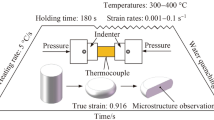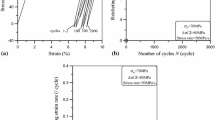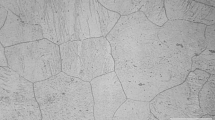Abstract
In this study, a series of experiments were carried out on the AZ31B magnesium alloy, including both a macro-experiment (mechanical experiment) and a micro-experiment (dislocation observation). Next, based on the consideration of the deformation mechanism of magnesium alloys (dislocation slip and twinning), a dynamic constitutive model of the magnesium alloy was established. In the developed model, the strain-rate-sensitivity control and the effect of temperature on the dynamic mechanical performance of the alloy were also investigated. The model parameters were determined by fitting the macroscopic experimental results. Next, the evolution of the micro-deformation mechanism was calculated by the developed model, and the trend of macro-mechanical behavior was also discussed.

















Similar content being viewed by others
References
Mukai T, Yamanoi M, Watanabe H, et al. Ductility enhancement in AZ31 magnesium alloy by controlling its grain structure. Scr Mater. 2001;45(1):89–94.
Hu H, Xi Q, Zhang D, et al. A novel severe plastic deformation method for manufacturing AZ31 magnesium alloy tube. Int J Adv Manuf Technol. 2018;98(1–4):897–903.
Song MJ, Huang CH, He M, et al. Numerical simulation of the forming limit of superplastic AZ31B magnesium alloy sheet. Mater Sci Forum. 2017;898:159–67.
Staroselsky A, Anand L. A constitutive model for hcp materials deforming by slip and twinning: application to magnesium alloy AZ31B. Int J Plast. 2003;19(10):1843–64.
Graff S, Brocks W, Steglich D. Yielding of magnesium: from single crystal to polycrystalline aggregates. Int J Plast. 2007;23(12):1957–78.
Proust G, Tomé CN, Kaschner GC. Modeling texture, twinning and hardening evolution during deformation of hexagonal materials. Acta Mater. 2007;55(6):2137–48.
Proust G, Tomé CN, Jain A, et al. Modeling the effect of twinning and detwinning during strain-path changes of magnesium alloy AZ31. Int J Plast. 2009;25(5):861–80.
Tang W, Zhang S, Peng Y, et al. Simulation of magnesium alloy AZ31 sheet during cylindrical cup drawing with rate independent crystal plasticity finite element method. Comput Mater Sci. 2009;46(2):393–9.
Choi SH, Kim DH, Lee HW, et al. Simulation of texture evolution and macroscopic properties in Mg alloys using the crystal plasticity finite element method. Mater Sci Eng A. 2010;527(4–5):1151–9.
Wang H, Wu PD, Tomé CN, et al. A finite strain elastic–viscoplastic self-consistent model for polycrystalline materials. J Mech Phys Solids. 2010;58(4):594–612.
Sun YD, Chen QR. Numerical simulation and experiment study on extrusion of AZ31 magnesium alloy tube. J Mater Eng. 2017;45(6):1–7.
Fernández A, Prado MTP, Wei Y, et al. Continuum modeling of the response of a Mg alloy AZ31 rolled sheet during uniaxial deformation. Int J Plast. 2011;27(11):1739–57.
Yu C, Kang G, Kan Q. Crystal plasticity based constitutive model for uniaxial ratchetting of polycrystalline magnesium alloy. Comput Mater Sci. 2014;84(1):63–73.
Herrera-Solaz V, Llorca J, Dogan E, et al. An inverse optimization strategy to determine single crystal mechanical behavior from polycrystal tests: application to AZ31 Mg alloy. Int J Plast. 2014;57(2):1–15.
Wu PD, Guo XQ, Qiao H, et al. A constitutive model of twin nucleation, propagation and growth in magnesium crystals. Mater Sci Eng A. 2015;625:140–5.
Cyr ED, Mohammadi M, Mishra RK, et al. A three dimensional (3D) thermo-elasto-viscoplastic constitutive model for FCC polycrystals. Int J Plast. 2015;70:166–90.
Cuitino AM, Ortiz MF. Computational modeling of single crystals. Model Simul Mater Sci Eng. 1993;1(3):225–63 (39).
Schoenfeld SE. Dynamic behaviour of polycrystalline tantalum. Int J Plast. 1998;14(9):871–90.
Nemat-Nasser S, Guo W, Liu M. Experimentally-based micromechanical modeling of dynamic response of molybdenum. Scr Mater. 1999;40(7):859–72.
Clayton JD. Modeling dynamic plasticity and spall fracture in high density polycrystalline alloys. Int J Solids Struct. 2005;42(16–17):4613–40.
Kuchnicki SN, Radovitzky RA, Cuitiño AM. An explicit formulation for multiscale modeling of bcc metals. Int J Plast. 2008;24(12):2173–91.
Safari KH, Zamani J, Ferreira FJ, et al. Constitutive modeling of polycarbonate during high strain rate deformation. Polym Eng Sci. 2012;53(53):752–61.
Knezevic M, Beyerlein IJ, Lovato ML, et al. A strain-rate and temperature dependent constitutive model for BCC metals incorporating non-Schmid effects: application to tantalum-tungsten alloys. Int J Plast. 2014;62(12):93–104.
García-Grajales JA, Fernández A, Leary D, et al. A new strain rate dependent continuum framework for Mg alloys. Comput Mater Sci. 2016;115:41–50.
Xie Q, Zhu Z, Kang G, et al. Crystal plasticity-based impact dynamic constitutive model of magnesium alloy. Int J Mech Sci. 2016;119:107–13.
Jia W, Xu S, Le Q, et al. Modified Fields–Backofen model for constitutive behavior of as-cast AZ31B magnesium alloy during hot deformation. Mater Des. 2016;106:120–32.
Lee WS, Lin CF. High-temperature deformation behaviour of Ti6Al4V alloy evaluated by high strain-rate compression tests. J Mater Process Technol. 1998;75(1–3):127–36.
Abbod MF, Sellars CM, Tanaka A, et al. Effect of changing strain rate on flow stress during hot deformation of type 316L stainless steel. Mater Sci Eng A. 2008;491(1):290–6.
Peng X, Guo H, Shi Z, et al. Constitutive equations for high temperature flow stress of TC4-DT alloy incorporating strain, strain rate and temperature. Mater Des. 2013;50(17):198–206.
Roth CC, Mohr D. Effect of strain rate on ductile fracture initiation in advanced high strength steel sheets: experiments and modeling. Int J Plast. 2014;56(4):19–44.
Lall P, Zhang D, Yadav V, et al. High strain rate constitutive behavior of SAC105 and SAC305 leadfree solder during operation at high temperature. Microelectron Reliab. 2016;62:4–17.
Lu SJ, Zhang B, Li XY, et al. Grain boundary effect on nanoindentation: a multiscale discrete dislocation dynamics model. J Mech Phys Solids. 2019;126:117–35.
Shen Z, Wagoner RH, Clark WAT. Dislocation and grain boundary interactions in metals. Acta Metall. 1988;36(12):3231–42.
Admal NC, Po G, Marian J. A unified framework for polycrystal plasticity with grain boundary evolution. Int J Plast. 2018;106:1–30.
Clayton JD. Dynamic plasticity and fracture in high density polycrystals: constitutive modeling and numerical simulation. J Mech Phys Solids. 2006;53(2):261–301.
Azizi R, Niordson CF, Legarth BN. On the homogenization of metal matrix composites using strain gradient plasticity. Acta Mech Sin. 2014;30(2):175–90.
Lee BJ, Vecchio KS, Ahzi S, et al. Modeling the mechanical behavior of tantalum. Metall Mater Trans A. 1997;28(1):113–22.
Bouvard JL, Francis DK, Tschopp MA, et al. An internal state variable material model for predicting the time, thermomechanical, and stress state dependence of amorphous glassy polymers under large deformation. Int J Plast. 2013;42(1):168–93.
Kalidindi SR. Incorporation of deformation twinning in crystal plasticity models. J Mech Phys Solids. 1998;46(2):267–90.
Oberson PG, Wyatt ZW, Ankem S. Modeling interstitial diffusion controlled twinning in alpha titanium during low-temperature creep. Scr Mater. 2011;65(7):638–41.
Chen ZH, Yang CH, Huang CQ, Xia WJ, Yan HG. Investigation of the twinning in plastic deformation of magnesium alloy. Mater Rev. 2006;20(8):107–13.
Preston DL, Tonks DL, Wallace DC. Model of plastic deformation for extreme loading conditions. J Appl Phys. 2003;93(1):211–20.
Ulacia I, Salisbury CP, Hurtado I, et al. Tensile characterization and constitutive modeling of AZ31B magnesium alloy sheet over wide range of strain rates and temperatures. J Mater Process Technol. 2011;211(5):830–9.
Cailletaud G, Sai K. A polycrystalline model for the description of ratchetting: effect of intergranular and intragranular hardening. Mater Sci Eng A. 2008;480(1–2):24–39.
Hong SG, Park SH, Lee CS. Enhancing the fatigue property of rolled AZ31 magnesium alloy by controlling 10–12 twinning-detwinning characteristics. J Mater Res. 2010;25(4):784–92.
Gao CY, Zhang LC, Guo WG, et al. Dynamic plasticity of AZ31 magnesium alloy: experimental investigation and constitutive modeling. Mater Sci Eng A. 2014;613(11):379–89.
Gao CY, Zhang LC. A constitutive model for dynamic plasticity of FCC metals. Mater Sci Eng A. 2010;527(13–14):3138–43.
Gao CY, Zhang LC. Constitutive modelling of plasticity of fcc metals under extremely high strain rates. Int J Plast. 2012;32–33(2):121–33.
Nguyen DT. A new constitutive model for AZ31B magnesium alloy sheet deformed at elevated temperatures and various strain rates. High Temp Mater Process. 2014;33(6):499–508.
Bhattacharya R, Lan YJ, Wynne BP, et al. Constitutive equations of flow stress of magnesium AZ31 under dynamically recrystallizing conditions. J Mater Process Technol. 2014;214(7):1408–17.
Xie Q, Zhu Z, Kang G. Dislocation-dynamics-based dynamic constitutive model of magnesium alloy. Acta Mech. 2017;228(4):1–8.
Kim WJ, Kwak TY. Constitutive modeling and understanding of the hot compressive deformation of Mg–9.5Zn–2.0Y magnesium alloy with reduced number of strain-dependent constitutive parameters. Met Mater Int. 2017;23(4):660–72.
Acknowledgements
This work was supported by the National Key Research and Development Program of China (2016YFB1200505), the National Natural Science Foundation of China (11672253), the Opening Foundation of State Key Laboratory for Strength and Vibration of Mechanical Structures (SV2019-KF-19), and the Applied Basic Research Project of Science and Technology Department of Sichuan Province, China (2017JY0221).
Author information
Authors and Affiliations
Corresponding author
Rights and permissions
About this article
Cite this article
Xie, Q., Zhu, Z. & Kang, G. Crystal-Plasticity-Based Dynamic Constitutive Model of AZ31B Magnesium Alloy at Elevated Temperature and with Explicit Plastic-Strain-Rate Control. Acta Mech. Solida Sin. 33, 31–50 (2020). https://doi.org/10.1007/s10338-019-00130-6
Received:
Revised:
Accepted:
Published:
Issue Date:
DOI: https://doi.org/10.1007/s10338-019-00130-6




